As a somewhat compulsive offroader in the Mojave Desert near Mesquite Nevada, I am preparing this list to better understand the native plants of the area. It is based upon the book "Native Plants of Southern Nevada: an Ethnobotany" by David Rhode. Hopefully you will find it useful in your riding.
Large Bushes and Vines:
Desert Plants: Succulents | Cacti | Lg. Shrubs | Sm. Shrubs | Herbaceous | Trees
Arrowweed (Pluchea sericea) [S Paiute: "sah-wape"]:
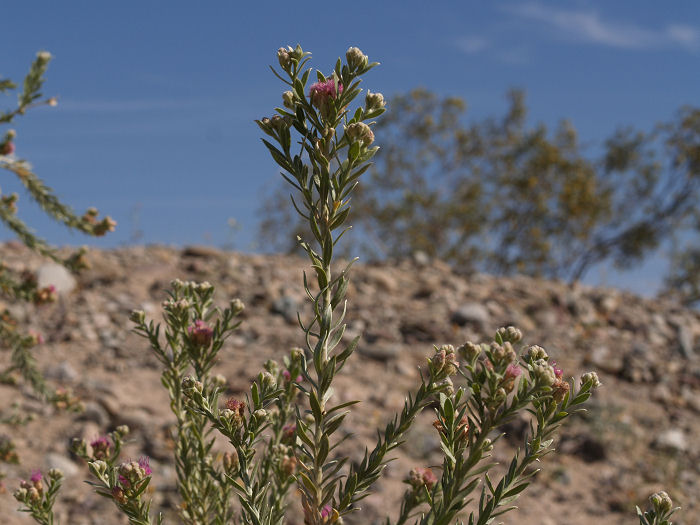
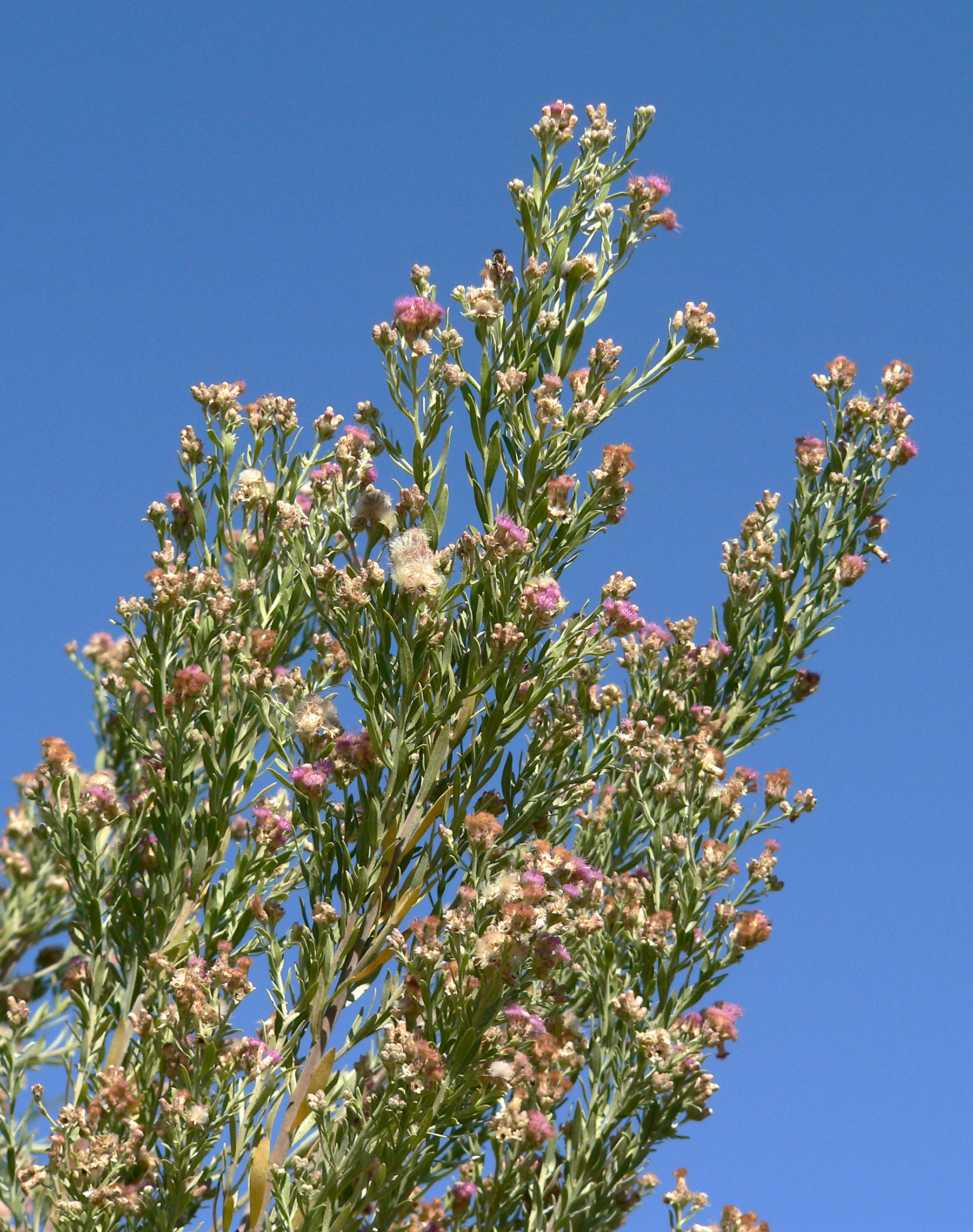
A willowlike shrub with long straight branches that grows to 15 feet tall. Its laceolate leaves are covered with white silky hair, producing a silvery gray color. Flowers are roseate purple tufts on branch ends and form white tufted seed heads. Grows with willow and bulrush in thickets near springs etc..
As the name implies the straight branches were used for making arrow shafts. In construction they were used for thatching of houses and granaries as well as lining roasting pits. Roots were boiled for tea or chewed raw to ease indigestion.
Canyon Grape (Vitis arixonica) [S Paiute: i'av, kuripsup; iyaavi (fruit); iyaavimpi (plant)]:

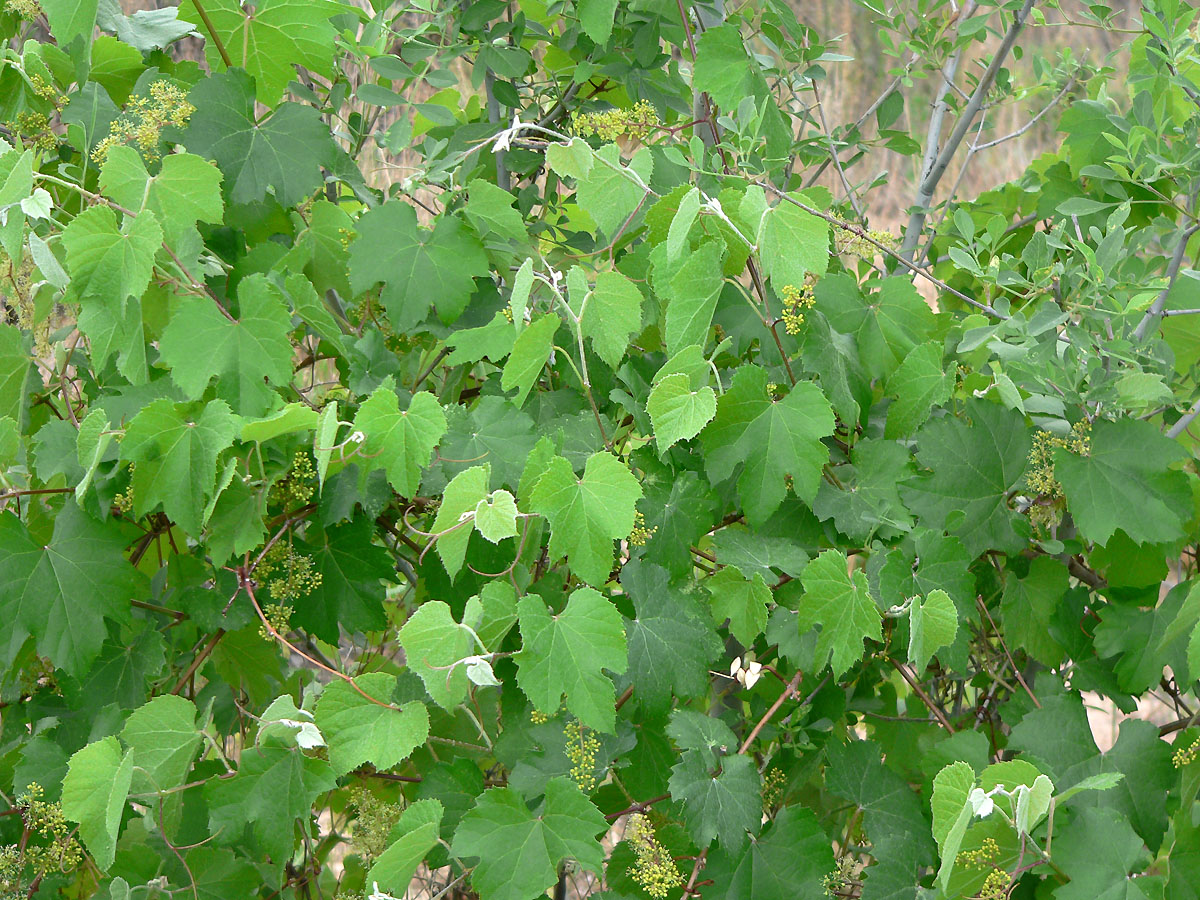
A large woody vine with climbing branches of maplelike leaves, shreddy bark and coiling tendrils. Juicy dark-blue fruit in summer and fall produced from wet moist soils near springs.
Grapes are eaten raw or dried and stored. They were cooked into jelly and wine. Seeds were saved and ground for various uses. Vines were used as ties and lashings in house construction. The plants were husbanded to widen their distribution. Southern Paiute people marketed them as a cash crop to white settlers.
Creosote Bush [Chaparral] (Larrea tridentata) [S Paiute: yatamp, yatumb, ya'tam'pi, "yatemp"]:
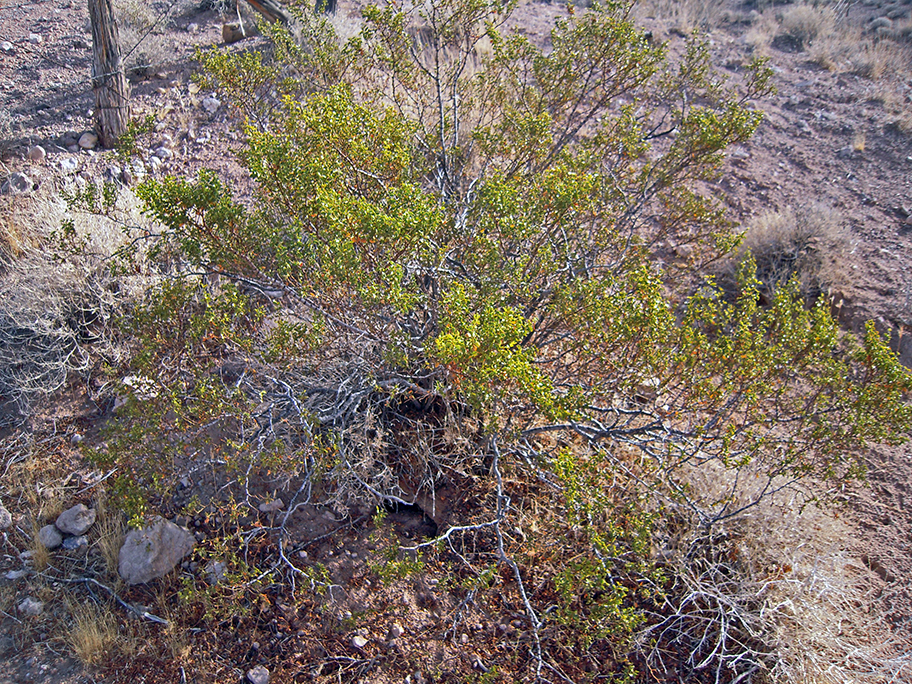
Beaver Dam Wash - Wint '09
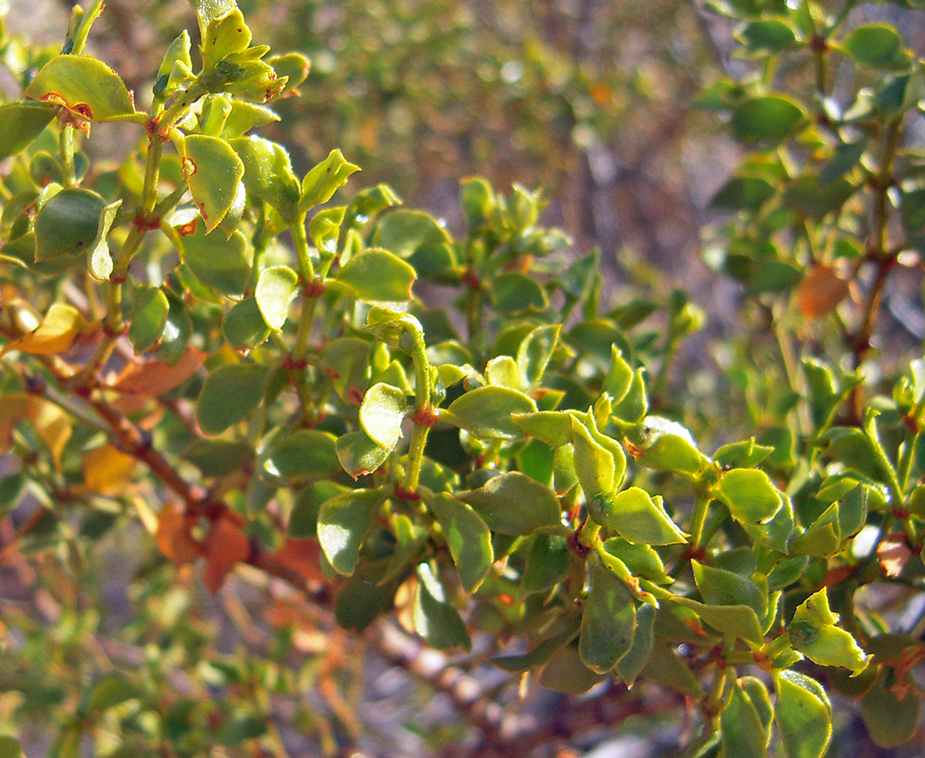
Beaver Dam Wash - Wint '09
Creosote Bush (Chaparral) is an evergreen shrub, 1-3 meters tall, whose stems bear resinous, dark green leaves with two leaflets joined at the base and smells of creosote. It develops yellow flowers having five petals. Eventually the old crown dies and the new one becomes a clone of the previous plant. One plant, near Lucerne Valley has been carbon dated to 11,700 years old.
Creosote was widely used as a herbal supplement by Native Americans. Used as a sunscreen it was also thought to be a potent antioxidant for the treatment of blood poisoning and hepatic diseases. Clinical studies today show that creosote does treat these disorders; However, it is very toxic to human liver cells. Ingestion is linked to a higher incidence of liver cancer, although extracts appear to be cytotoxic and inhibitory to other forms of cancers. The U.S. FDA has issued warnings against it's use because of its carcogenicity. It is used also for fuel, shade, tools, glue, sealant and waterproofing.
Fourwing Saltbush (Atriplex canescens) S [Paiute: "que-ahe-que"; "ova-va-na-ha-ve"; murunib]:
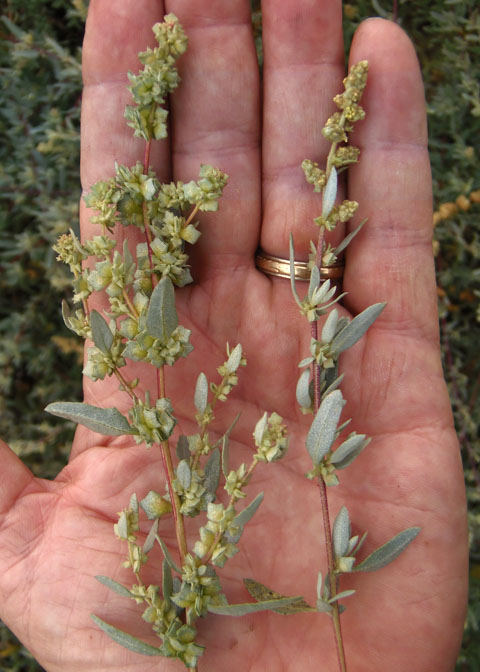
Ron Vanderhoff

An erect woody shrub, 2 - 4 feet high, it has intricate branches, scurfy twigs and small pale grayish-green, elongated leaves. Flowers become pale green fruit clusters with four distinctive wings. It is one of the most consitently found species below 7500 feet in the transition zone between the Mojave and Great Basin deserts.
Its hard wood is used as firewood, for arrows and even arrowheads. Seeds were used as food and fresh-ground roots were boiled with salt for a "physic." Leaves were rubbed on sores as a healing agent.
Shadscale (Atriplex confertifolia) [S Paiute: kakumb, "que-ahe-que," "kakumba"]:
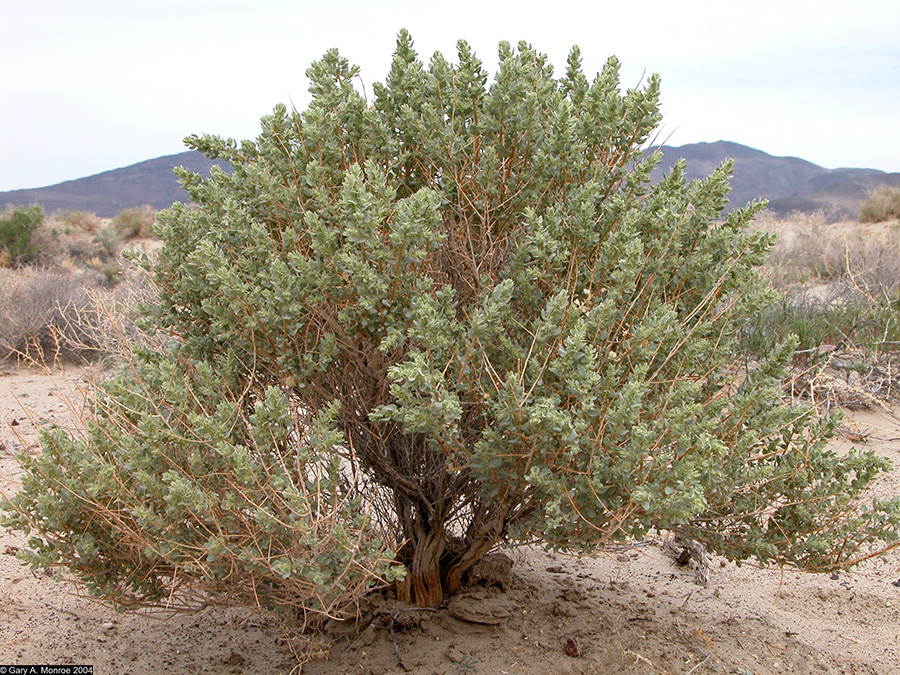
Gary Monroe

Wikipedia
The most abundant shrub in the region, it is a large woody shrub up to 4 feet in diameter with a maze of zig-zagging twigs having spiny tips. Pale gray-green scurfy leaves drop during drought exposing twigs. It has triangular fruits with two leaflike wings. It seems to like heavily textured, slightly salty soils.
Fresh leaves were made into a poultice or powder to heal cuts and is still used today for medicinal purposes. The wood burns well and seeds can be eaten. It is eaten for forage and for winter and spring animal browse.
Greasewood (Sarcobatus vermiculatus) [S Paiute: Tonovi]:
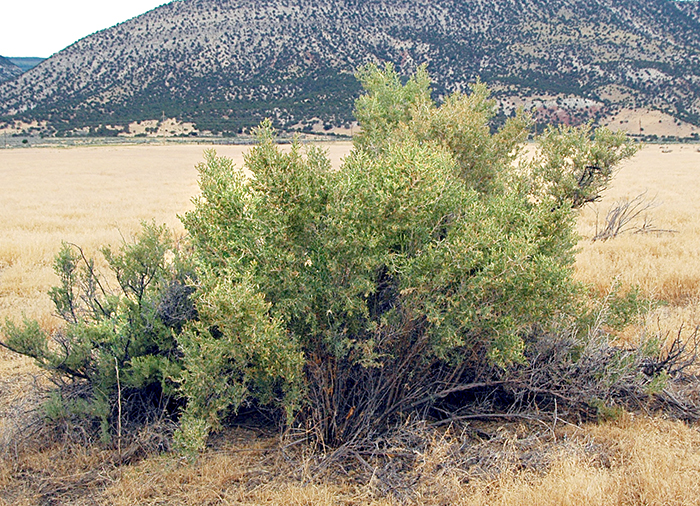
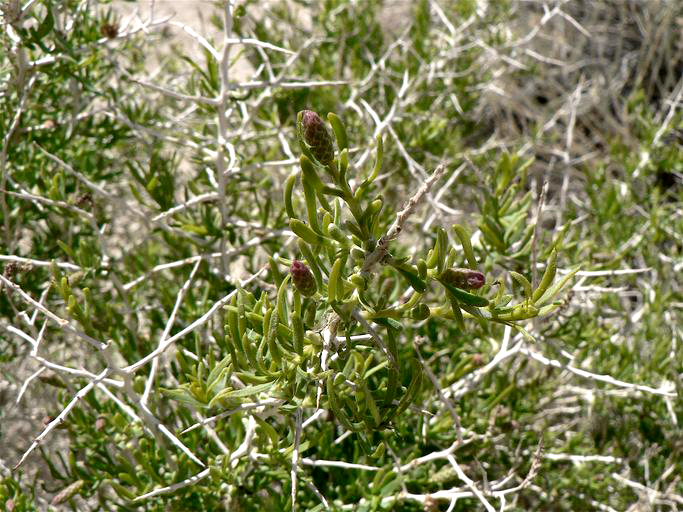
A large woody shrub growing to 5 feet tall it has intricate spine-tipped, whitish twigs, dark gray branches and bright green succulent leaves. It is found in valley bottoms and has salt tolerance and thrives in those areas. It is more common in the cooler Great Basin and less so in the hot Mojave.
Its tough branches make digging sticks, arrow foreshafts, arrow points, cradleboard and basket edges and other items requiring hard wood. Seeds were occasionally used for food.
Anderson's Wolfberry [Tomato berry, Desert thorn] (Lycium andersonii) [S Paiute: pa'up, u'up, hu'up; "hoop-pi-ve" (bush); "huppo" (berries)]:
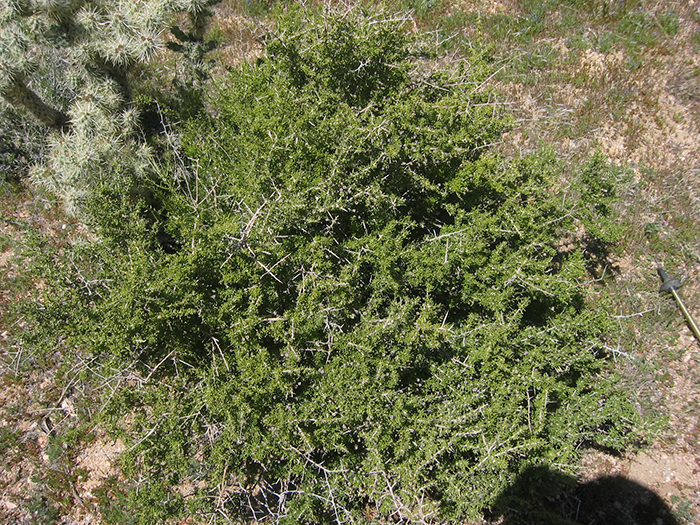
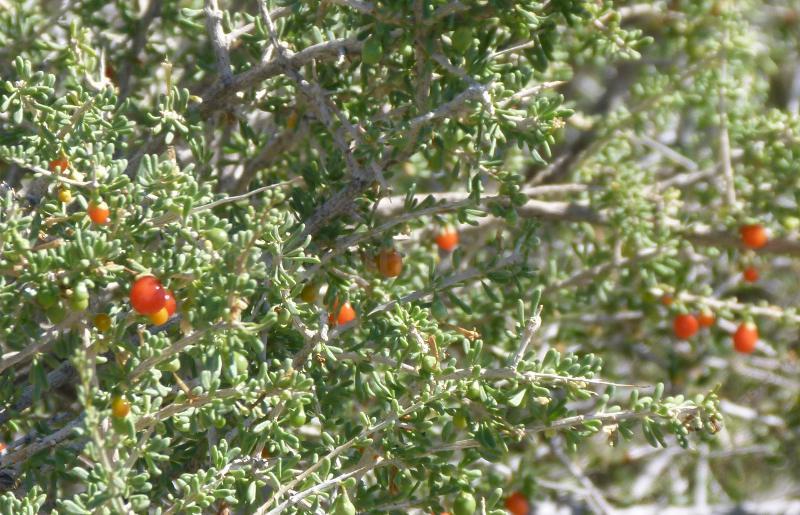
It is a thorny shrub growing to 10 feet tall with many zig-zagging branchlets. There are small, succulent, sausage-shaped leaves and produces light lavendar flowers. The tomato-red berries are small and the plant is widely distributed under 6000 feet on gravel and rocky slopes.
The berries and juice were sought after and higly prized. The thorns made it difficult to harvest but they could either be eaten fresh or were beaten in a basket with a stick for juice and pulp. They could be dried whole or mashed and could be kept for several years.
Nevada Smokebush [Dotted dalea] (Psorothamnus polydenius) [Paiute: "cuy-utsie"]:
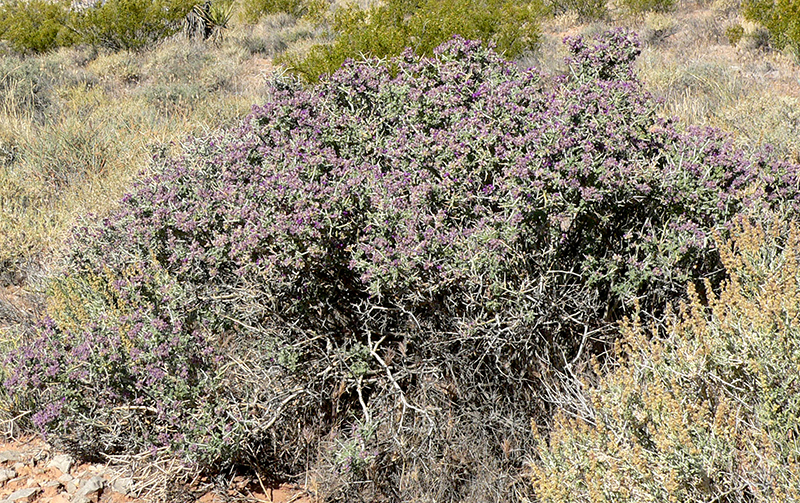
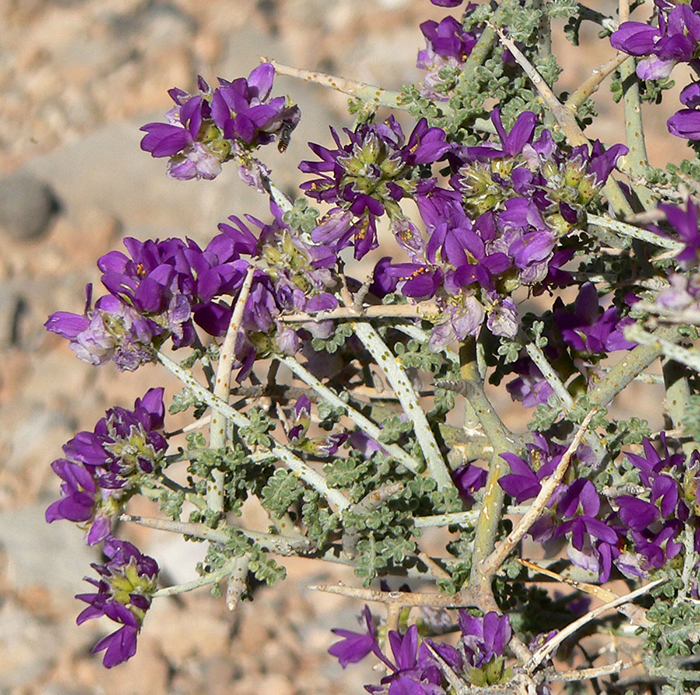
Smoke bushes are shrubs up to 5 feet tall, with angular stiff stems and few leaves but tapered, spine-tipped ends. Tiny leaves fall off in the summer and yellow-orange pinhead-sized glands over green stems give off fragrance. Pea-shaped flowers are deep purple. Grows on loose sand and conglomerate.
Flowers of this plant is a well known cold and cough remedy. A tea was made from boiling fresh or dried stems to treat tuberculosis, influenza and pneumonia. Its flowers were mixed with native tobacco and smoked. Seeds were also ground into paste or flour.
Fremont's Dalea [Indigo bush] (Psorothamnus fremontii) [S Paiute: "i-era-midja"; "po-heda-watu"]:
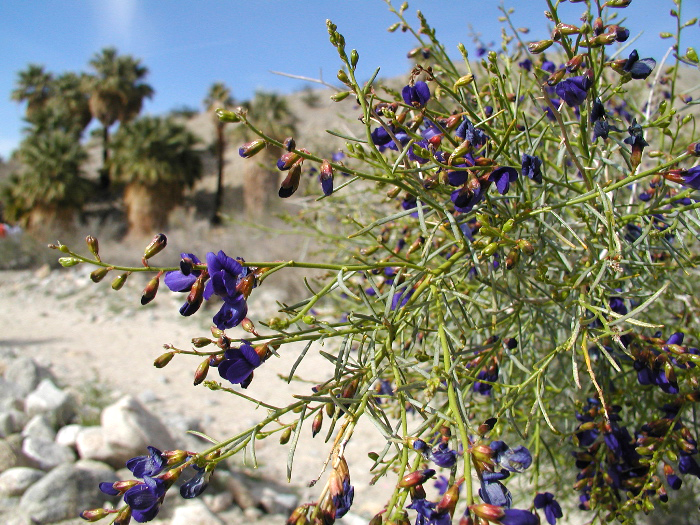
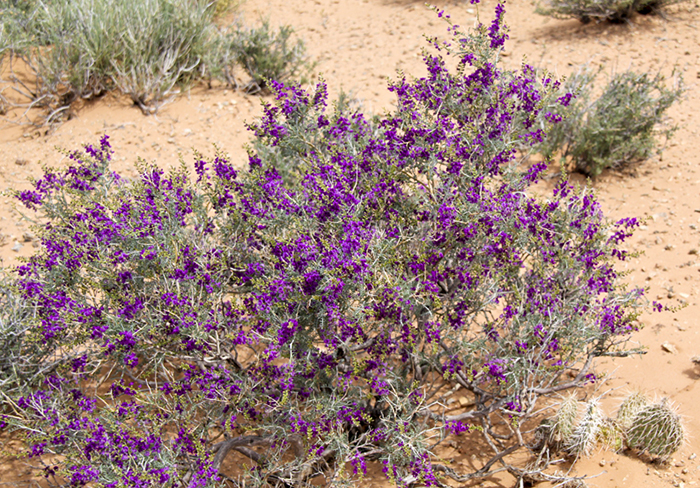
Lynn Sessions
Fremont's Dalea is similar to Nevada Smokebush except smaller (less than 3 feet), has silvery foliage and develops elongated deep purple flower clusters. Is found on limestone and volcanic slopes associated with Mojave Desert shrubs.
Roots are boiled for tea to stop internal hemorrhages or stomach trouble; stems, leaves and flowers cooked or steeped into a beverage.
Nevada Jointfir [Gray Mormon Tea] (Ephedra nevadensis) [S Paiute: yatup, utupi, tutupi, "tu-tupe"]:
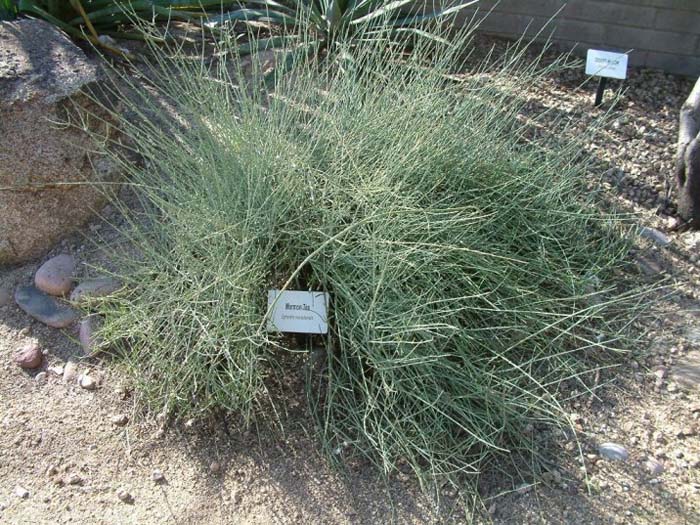
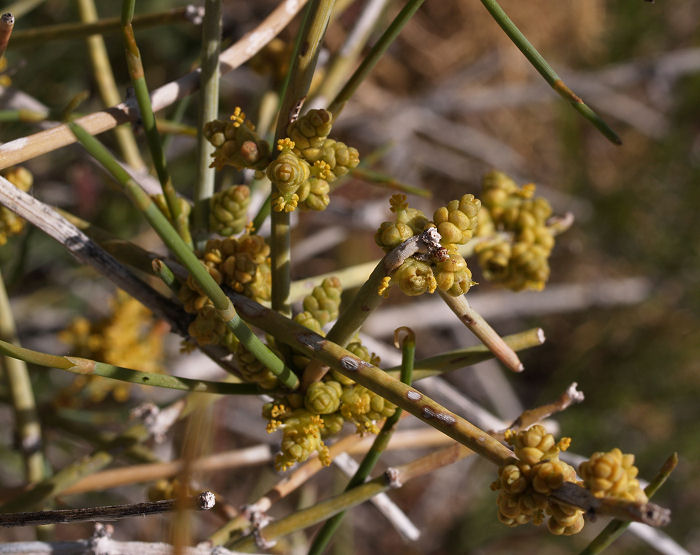
Like Green Mormon Tea, Nevada Jointfir is a broomlike shrub growing to 3 feet high with jointed yellow/green stems and tiny scale-like leaves in two's or threes at each joint. They bear both male and female cones which resemble but are not flowers. It is marked by its gray-green or brown-green color and spreading, stout branches and grows in grows in dryer climates than its cousin Green Mormon Tea, and at lower elevations (2000-6000 ft).
Gray Ephedra is more bitter than its green cousin when its stems are steeped into tea. It treats a variety of stomach, kidney and other internal ailments. It was used to treat venereal disease (with ballhead gilia [Ipomopsis congesta] combined) and stimulate urination. Roots and stems boiled with salt water made a psysic. Dried and pulverized stems could be applied to sores or mixed with pine pitch as a salve. Seeds were eaten raw or made into flour. Roots were ground for chewing gum and its charcoal was embedded into the skin by a horsebrush spine [Tetradymia] for tatoos.
Green Mormon Tea [Indian tea] (Ephedra viridis) [S Paiute: yatup, utupi, tutupi, "tu-tupe"]:
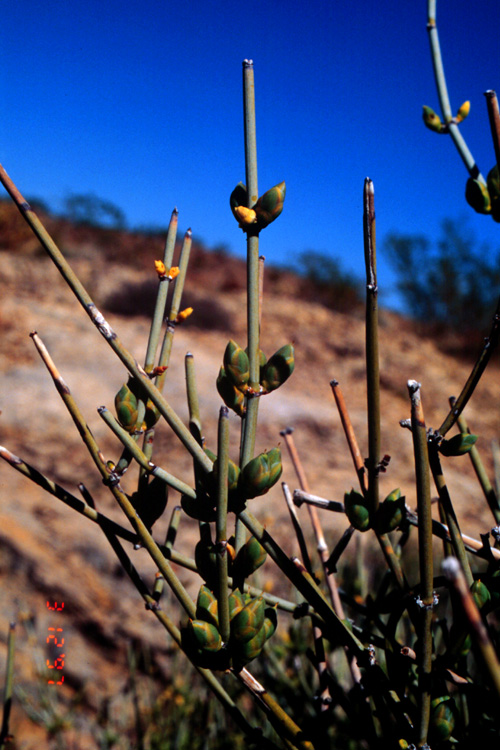
Christopher Christie

Logandale Trails, Spring 09
Like Nevada Jointfir it is a Broomlike shrub to 3 feet high with jointed green stems and tiny scale-like leaves in two's at each joint. Except Green Mormon Tea is bright green with numerous parallel branches pointing upward and grows at higher elevations (4500-6000 ft).
Stems brewed for tea and to treat stomach, kidney and other internal disorders for colds and by frontiersmen for venereal disease. In the desert, people chew a piece of the twig to relieve the pain of sunburned lips. It contains the alkaloid ephedrine, a medication which constricts the blood vessels, dilates the bronchioles, and stimulates the central nervous system. Use for seed-food, ground-root chewing gum and charcoal for tatoos. It also contains large amounts of tannin, in addition to a resin and a volatile oil.
Rubber Rabbitbrush (Ericameria nauseosa) [S Paiute: sikump, s'kump, wa'arump, sikimpi]:
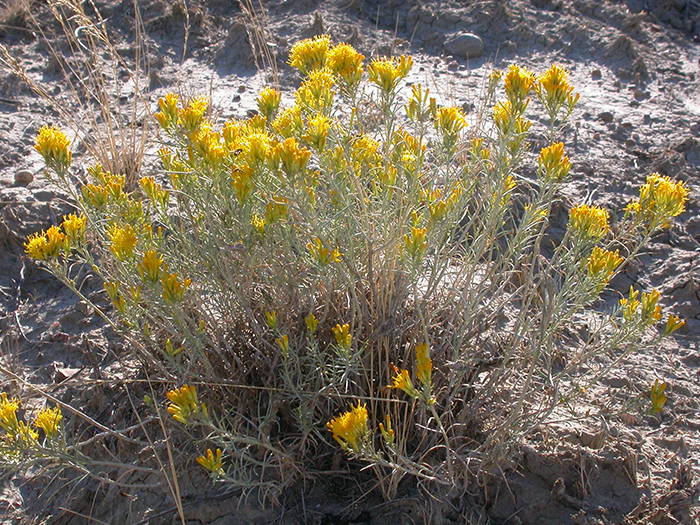
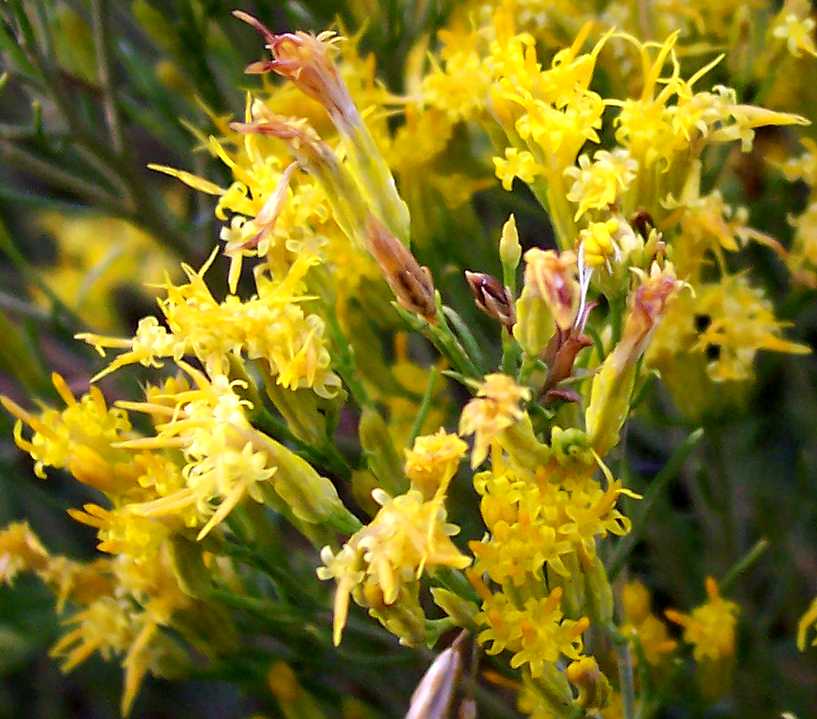
Rabbitbrush has related genera and a wide variety of sub-species. It is a densely branched, round-topped plant about 2-4 feet high. It has narrow, gray-green, 1-2 inch leaves and bright yellow flowers in late summer-fall. It has high rubber content in its foliage and grows on sandy soil especially along washes.
Leaves were steeped for tea in stomach disorders and colds. Tops and roots were boiled for cough, colds and other ailments. Leaves were macerated to a poultice for rheumatism. The whole plant of another species was made into a liniment. Roots were used for chewing gum sometimes colored with tiger lily [Lilium lancifolium] petals. Branches were used as both roofing material and for brushes to apply pitch to water jugs. The bright yellow, late-summer blooms signal that mountain pine nuts were ready to harvest.
Big sagebrush (Artemisia tridentata) [S Paiute: sanwav, sanwabi, "sa-wa-ve"]:
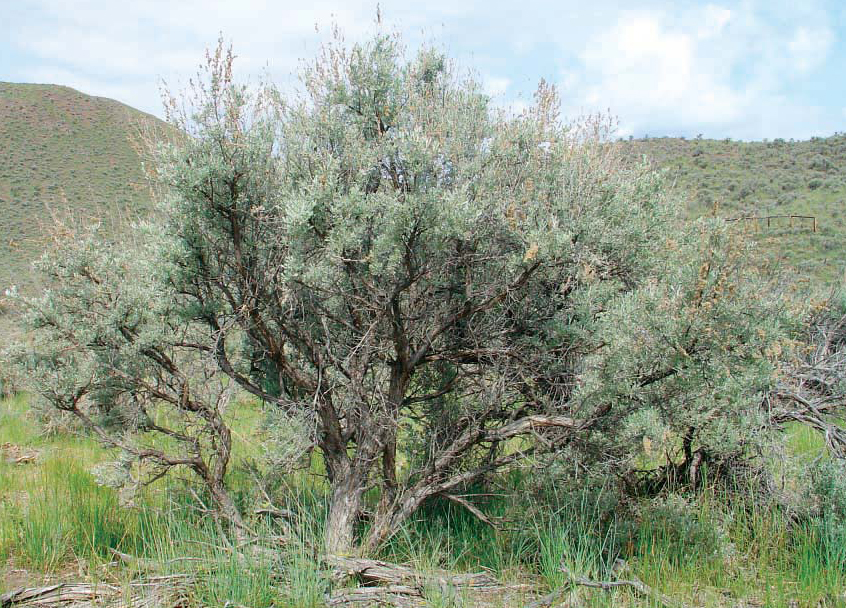
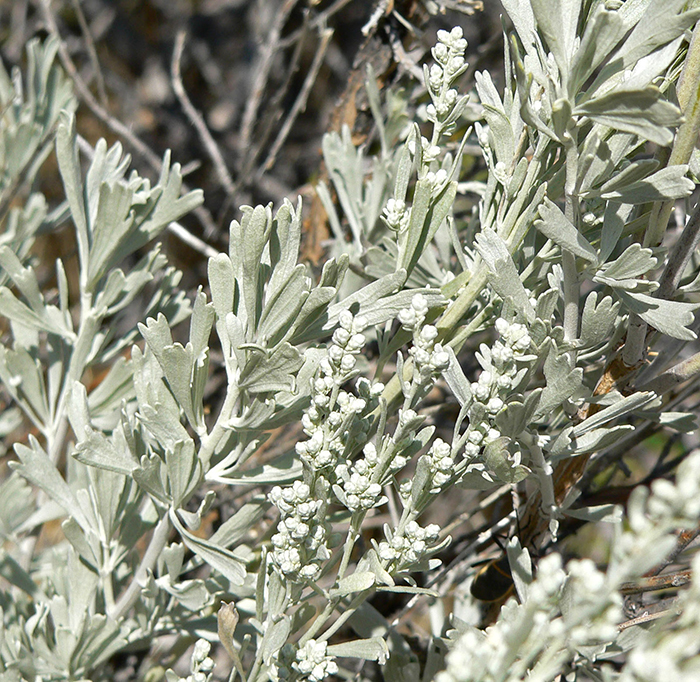
This is the "icon" of the cooler Great Basin desert, a dominant plant above 5000 feet. Plants can be rounded or spreading about 2-10 feet high and very fragrant. It has twisted, sinuous branches with fibrous bark and wood which flakes off in strips. The narrow, wedge-shaped leaves have a hairy, blue to green-gray surface and three small lobes at the tip. Following a rain the odor of sagebrush is pretty much the sine-que-non of the desert.
The big sagebrush is greatly important as a medicinal plant. Green leaves and tops were chewed or steeped into a tea to treat headache, cough, colds, stomach ailments, sore eyes and worms. A leaf poultice was applied to chicken pox or small pox scars, cuts and bruises. The tea would produce sweating during fever and was used as an antiseptic wash. A warm decoction of leaves was used to bathe newborns and menstruating women would use a sage stick as a head-scratcher because "any other kind would cause the hair to fall out and the face to wrinkle."
Hogan's were fumigated with sagebrush smoke following an illness as well as for "purifying" baskets and blankets in childbirth; and, it had many "sweatlodge" and other religious uses. As a raw material it was used in construction, fires and building fire starting equipment. The bark was used for twining into ropes, bags and garments. Bark was pounded into a lining for winter shoes and to cork water baskets. Lac found on the plant could be shaped into handles for awls and knives or used for glue. Sage lined Pinyon roasting pits (but not for Yucca because it made a bitter taste). Seeds tossed into the fire popped like firecrackers but were bitter, so only used for food in times of want. Blossoms are occasionally used to flavor wheat flour.
Stansbury Cliffrose (Purshia stansburiana) [S Paiute: u'nup, "hunupi," ina'pi']:
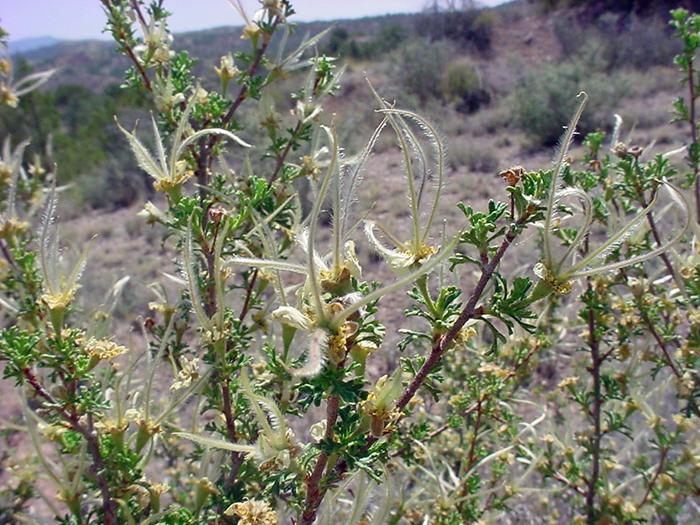
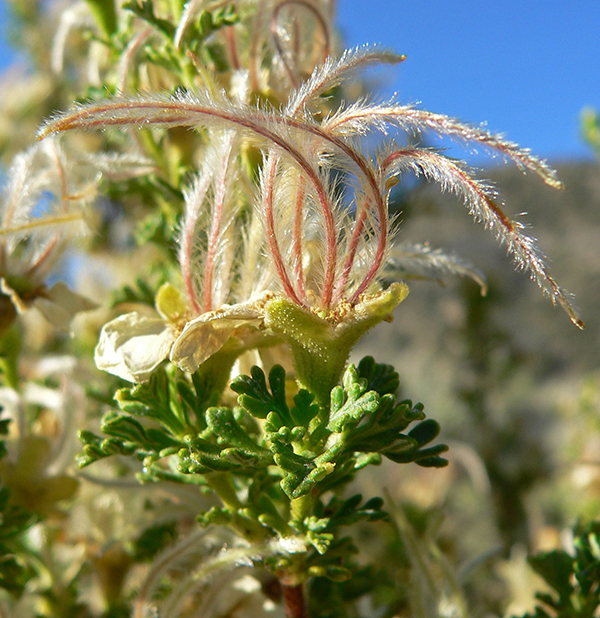
Stansbury Cliffrose is closely related to the Desert Bitterbrush. They can grow as large as a small tree (12 feet), have irregularly branched trunks with fibrous bark, gray-brown in color. The branchlets of the plant sport small clusters of evergreen leaves which are wedge shaped and deeply incised into 5-9 deep lobes at tips and are finely hairy underneath. It has snowy white five-petaled flowers in the spring which mature into feathery-plumed fruits. It grows with sagebrush-Pinyon communities in mountains of 4200-7000 feet.
Like the Bitterbrush, the plant was an important fiber source for diapers, rope, string, cloth, sandals, infant blankets and "house crosses" to protect against thunder and lightening. It was woven into mats and used as a vermin repelling lining of food caches. Also, the bark made a medicinal poltice, ceremonial smoke, and was used for fuel. Seed tea made a violet dye. Leaf tea was an antiseptic wash, and was used to treat small-pox and measles. The golden tea was sometimes combined with Pinyon pitch or with crushed lichens and dried woodrat urine. When leaves, stems, roots and inner bark was boiled, the resulting liquid was used to treat venereal disease, colds and back pains or it could be used as an emetic, physic or laxative.
Desert Bitterbrush (Purshia glandulosa) [S Paiute: u'nup, "hunupi," ina'pi']:
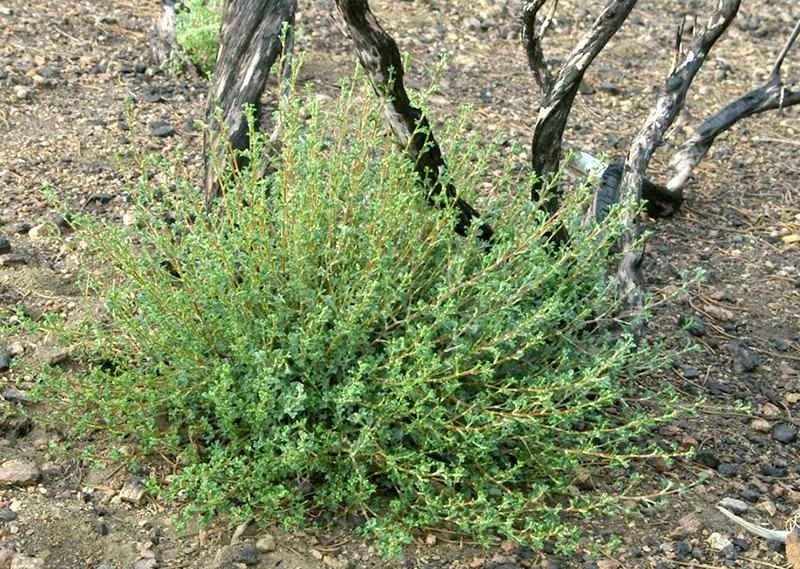
Tom Schweich
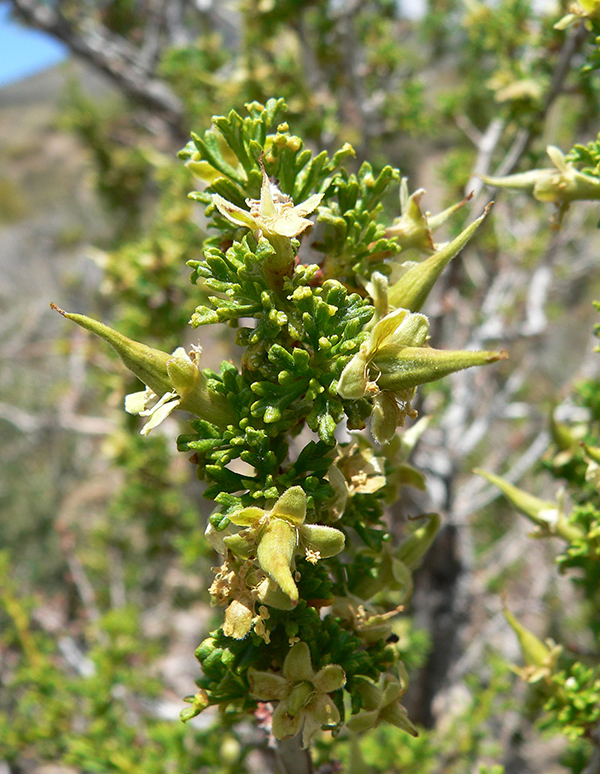
Desert Bitterbrush is closely related to the Stansbury Cliffroase (above). It shares physical characteristics except that it has leaves which are glandular, a bit sticky and are divided into 3-5 lobes. It also has smaller, yellow or cream-colored flowers which are less showy than cliffrose. Its fruits are conical and taper to a peak, rather than a plume. Bitterbrush is common in washed and slopes between 3200 and 6000 feet.
Like the Cliffrose, the plant was an important fiber source for diapers, rope, string, cloth, sandals, infant blankets and "house crosses" to protect against thunder and lightening. It was woven into mats and used as a vermin repelling lining of food caches. Also, the bark made a medicinal poltice, ceremonial smoke, and was used for fuel. Seed tea made a violet dye. Leaf tea was an antiseptic wash, and was used to treat small-pox and measles. The golden tea was sometimes combined with Pinyon pitch or with crushed lichens and dried woodrat urine. When leaves, stems, roots and inner bark was boiled, the resulting liquid was used to treat venereal disease, colds and back pains or it could be used as an emetic, physic or laxative.
Skunkbush Sumac (Rhus trilobata) [S Paiute: su'uv, "see-a-wimp," siiwimpi, siovi (bush)]:

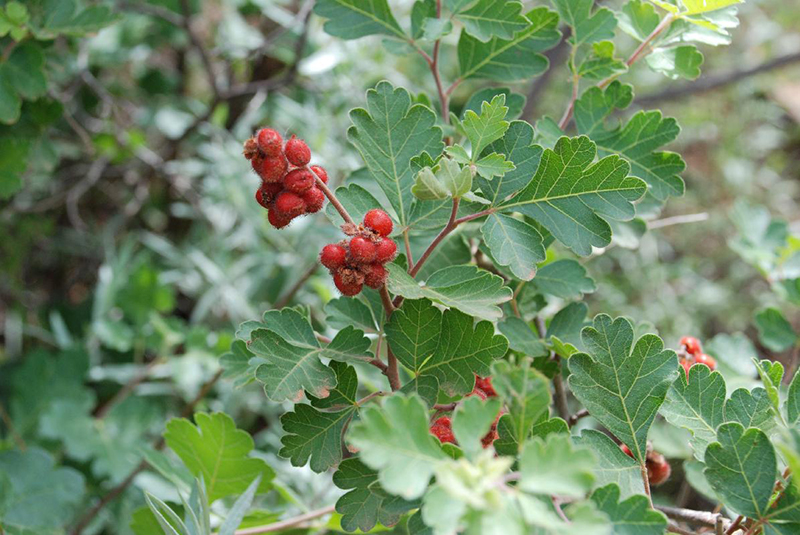
This spreading shrub grows 3-10 feet tall and wide. It has slender and arched stems with smooth brown bark; as well as deeply lobed, compound leaves with three wedge shaped, shiny-smooth or velvety leaflets. Small yellow flowers are clustered at end of branches and mature to tart, reddish-orange fruit. It grows in dry, rocky slopes and cliff faces with Sage-Pinyon-Juniper and occasionally in moist valley bottoms with Sage-Blackbrush.
Young branches are used for cradleboards, winnowing trays and other baskets. They were transplanted, pruned and burned to encourage growth and used as superior to willow either split or un-split. It is becomming increasingly rare and is still used for wedding blaskets. Stems and leaves were boiled with pinyon pitch and yellow ochre to produce a black dye used on buckskin, feathers, wool or basketry materials. Red fruits were either ground or dried for beverages.
Wood's Rose (Rosa woodsii) [S Paiute: ciampibi, ci'impipi (hips)]:
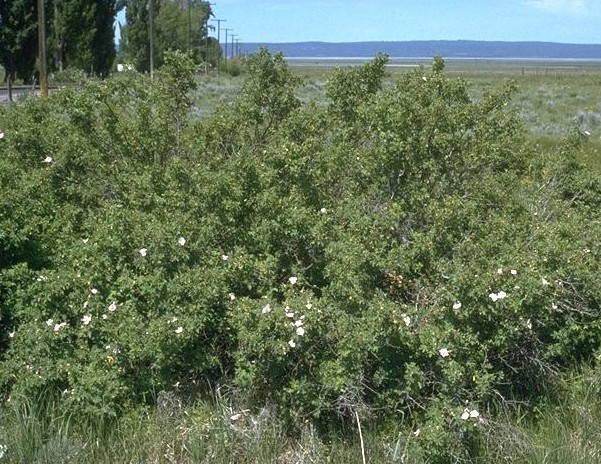
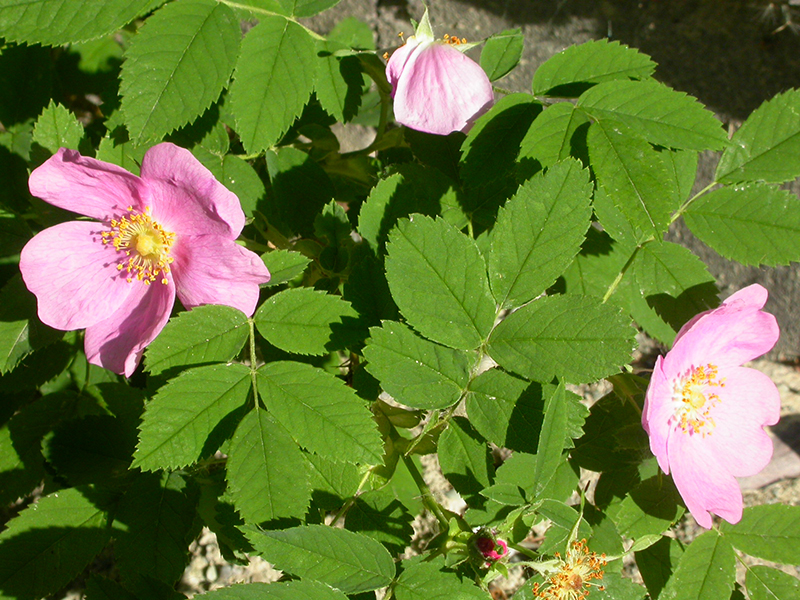
Like other roses, Wood's Rose is a many branched, prickly shrub growing up to 3 feet tall. It has pink, urn-shaped flower cup which produces a fleshy, red-dish orange hip full of seeds. Not common in S. Nevada, it prefers moist, mountain settings near springs or washes. It grows in thickets on most Great Basin mountain ranges with pinyon and yello pines and fir for compnaions.
It is an excellent source of vitamin C, so pods were eaten by most every native group and some ate the flower buds. Leaves were used as tea and a tonic; roots and inner bark were steeped for colds and a diuretic. Other parts were used to dress wounds, cuts, sores, burns and swellings when applied dry or moistened. Shavings or powder of peeled stems were bandaged with a wound and could alleviate swelling, pain and promote healing. Seeds were used to ease bowel disorders and is still used today. Branches could make arrow shafts if greased when dry to prevent cracking. Stems were used for rims of baskets. Girls strung either rose buds or hips together to make neckalces.
Desert Snowberry (Symphoricarpos Longiflorus) [S Paiute: tampisudupi, avagunimpi]:
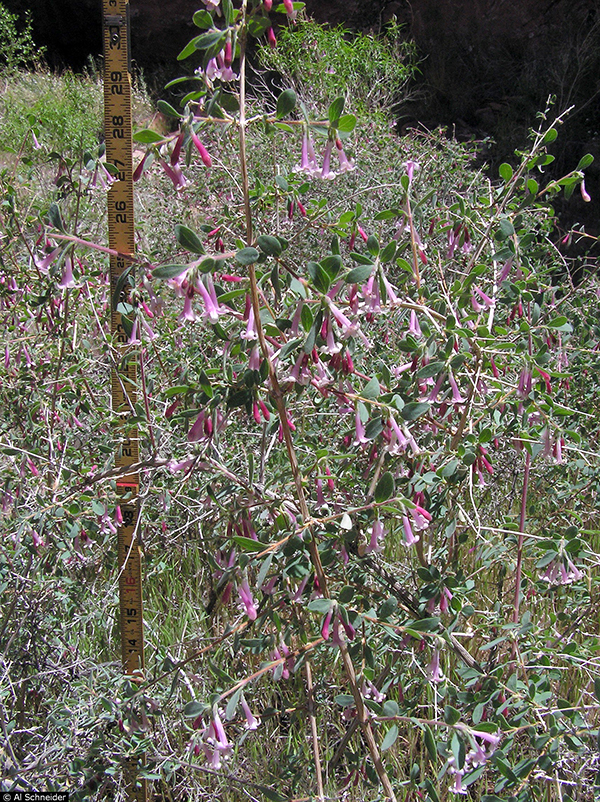
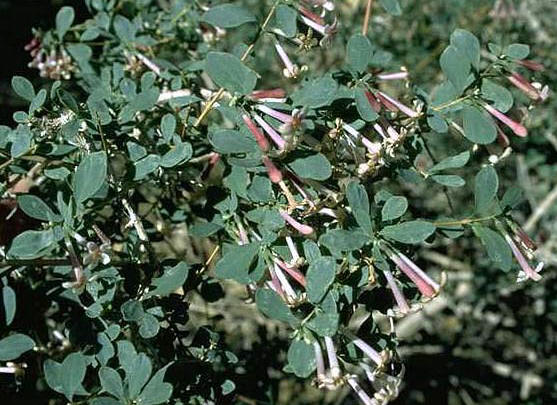
This is a spreading to straggling shrub growing to 1-4 feet high with red to grayish branches, shreddy bark, and opposing twigs. It has small, round-to-oval leaves which are also paired opposite each other. Pink trumpet-shaped flowers are between a half and three-quarter inches long and mature to round/oval, waxy, white berries.
Tea was used as a digestive; bark was shredded for string; and, shoots were hollowed for arrow shafts to hunt birds. Its light outside and thick pith made it excellent for controlling the weight of the arrow shaft. The plant was clutivated by cutting the plant down in the fall so the newly growing shoots would be straight and smooth the next autum when needed. Berries could also be used for food.
Gooseberry (Ribes ssp.) [S Paiute: pogompi]:

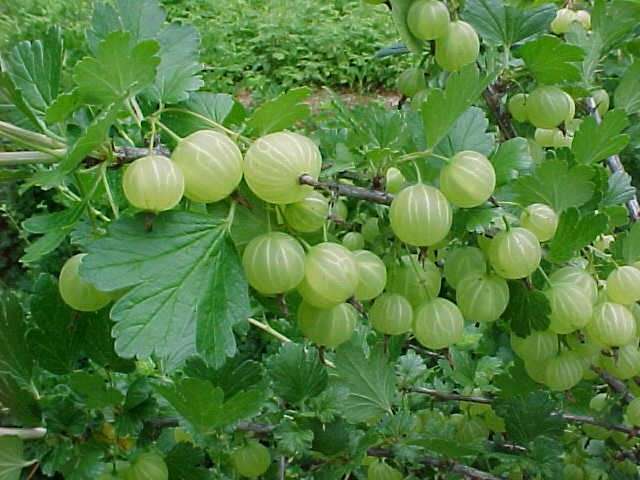
Gooseberry (also called Currant) is a rounded, multibranched shrub growing up to 6 feet with leaf clusters at short branch ends. Their three-to-five lobed, round-to-wedge shaped leaves have conspicuous light green veins. Clusters of white flowers produce red-to-black berries. There are several species, most of which grow in meadows and forests above 6000 feet (Golden Currant, Wax Currant). The desert or plateau gooseberry grows on volcanic mountains with sage and pinyon-juniper companions above 5300 feet.
These berries were widely gathered in the area for food: fresh, cooked or dried for storage. They could be reconstituted by soaking in water or being boiled then treated with a little sugar just like when they were fresh. (Some peoples reported that wax currants gave them headaches). The inner bark of the golden currant was used to cure sores and stems were straight and hard enough to make arrow or spear shafts.
Utah Serviceberry (Amelanchier utahensis) [S Paiute: tiabi, tiwabi, tiav (plant), tiwampi (berries)]:
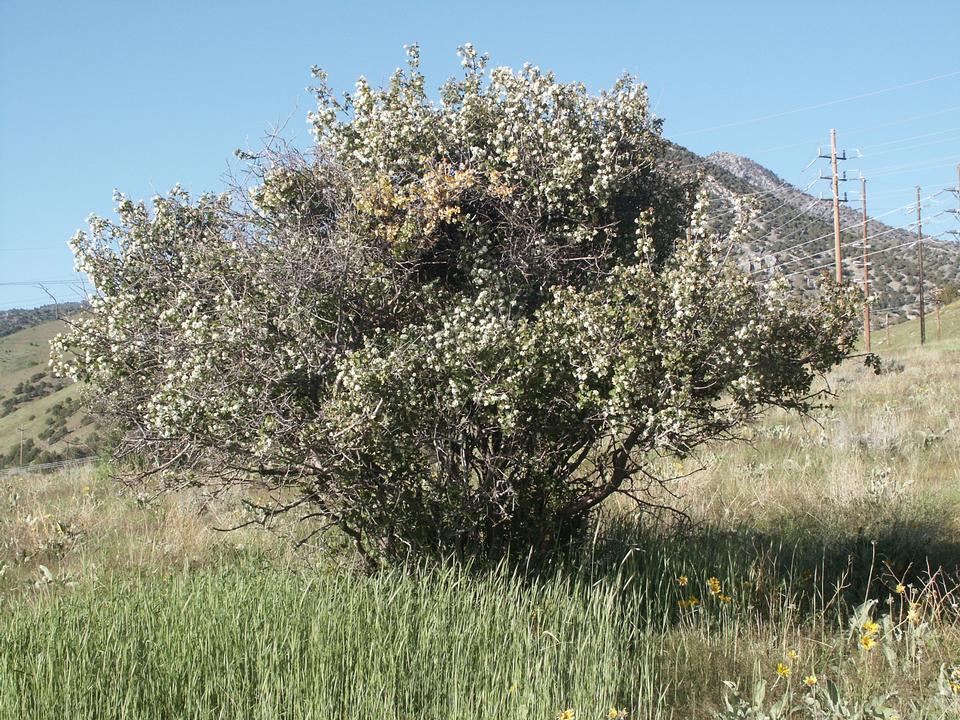
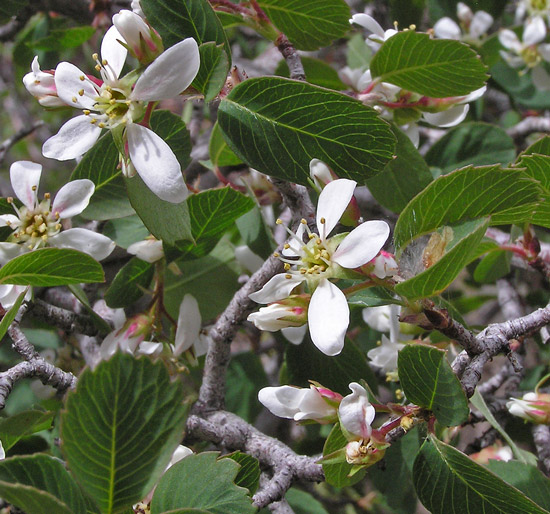
This plant is a large spreading shrub which grows 3-12 feet tall and has oval leaves. There is a perfusion of white flowers followed by purplish fruits that persist, dry, on the branches until the fall. It grows in companionship with Sage, pinyon, juniper, yellow pine and fir in the mountains between 5 and 9,000 feet. It likes open, rocky slopes, washes, cliffs and outcroppings.
They have small currant-like fruits which are gathered in the fall and used dried and ground to be reconstituted like "canned tomatoes." They were mixed with fruits and dried meats as pemmican for winter (and traveling) use. Small seeds were also mashed and used for cakes to dry and store. The green inner bark was boiled with sugar for snowblindness. Construction projects in which this plant was used include: arrow shafts, cradleboard frames, basket rims, digging sticks and possibly for bows.
Blue Elderberry (Sambucus cerulea) [S Paiute: kunuk'wi, "kon-vee"]:
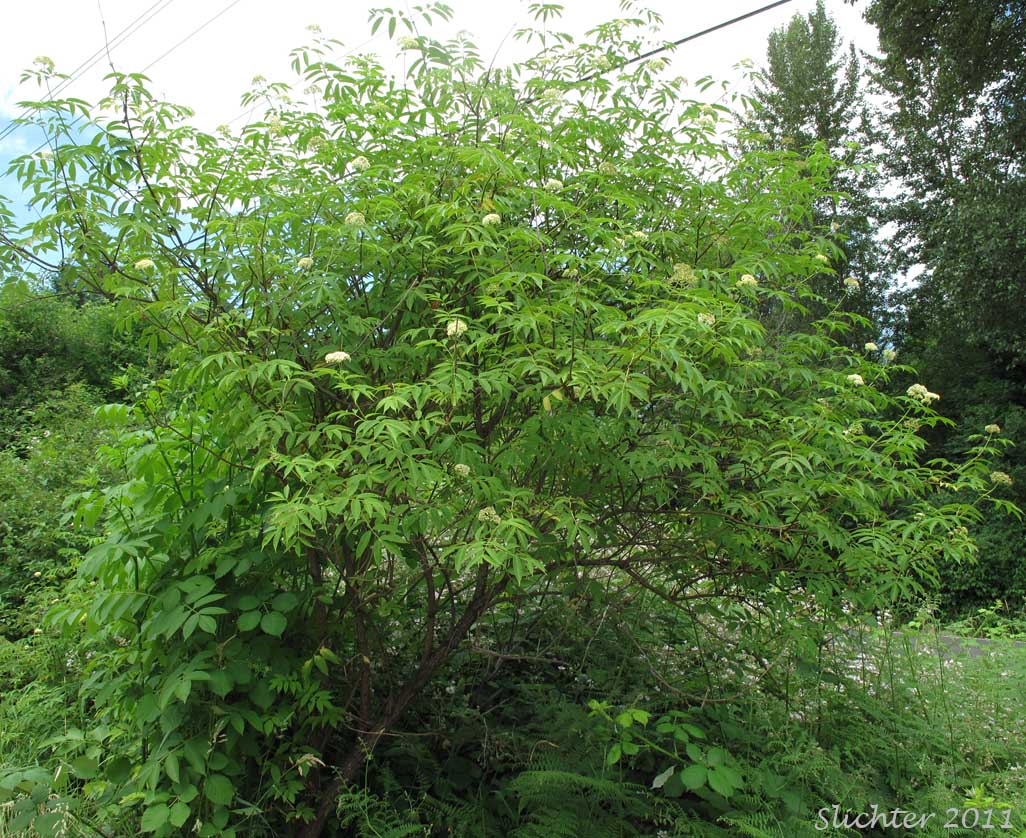
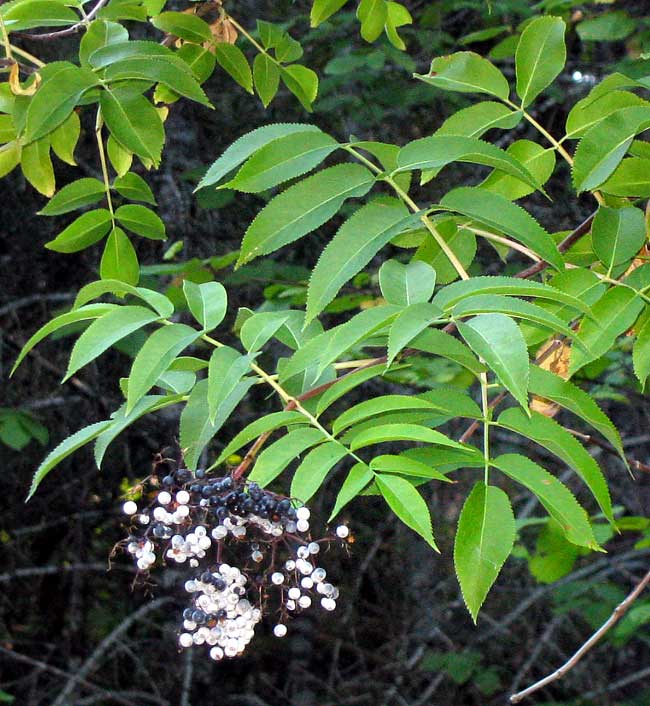
This plant is a large, multitrunked, spreading shrub or small tree 6-25 feet tall. Five to nine smooth-surfaced, green (above) pale- green (below) leaflets compose each leaf and are saw-toothed along both edges. Spring umbrella-like (or flat topped), delicate, white flower clusters, form at ends of branches and turn to clusters of bluish-black berries covered with dense waxy powder. It grows in moist places along streams or under the shade of cliffs along with pinyon-juniper, yellow pine or fir companion plants at between 5600 and 9100 feet.
These wera a main, mid-summer berry eaten fresh, sun dried on rocks or boiled into jelly. Hung in skin bags they were ready for storage until winter needs. Who doesn't like elderberry jam? Flowers and leaf steam vapors were used for colds and headaches. Flower tea was found to relieve fever and measles. Limbs affected with "blood poisoning" were soaked in hot elderberry leaf tea. Six-holed flutes or whistles were made by scraping out the soft pith and used in curing rites. Hollowed out branches were also used to store tobacco or a tobacco-lime mixture. Stems were one of the materials used for cradleboards and baskets and canes for arrow and dart shafts.
Desert Plants: Succulents | Cacti | Lg. Shrubs | Sm. Shrubs | Herbaceous | Trees